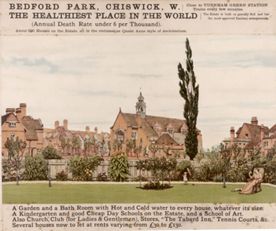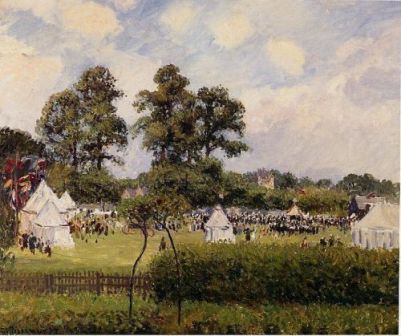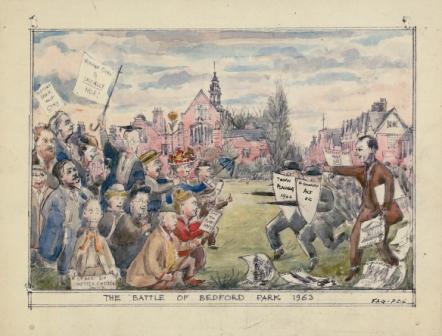
Bedford Park

House prices in Chiswick today may have had their roots in the marketing genius of the first developers. This 1882 advertisement for Bedford Park presents a cunningly distorted picture: the garden in the foreground could never have existed on the scale depicted, and St Michael's church has been elevated so that its entrance looks over the wooden fence.
St Michael & All Angels Church lies at the heart of Bedford Park, a residential area developed between 1875 and 1886 and acclaimed as the world's first “garden suburb” - forerunner by over thirty years of Letchworth and Welwyn Garden City.
Map of the Parish of Bedford Park
The development owed much to the “Aesthetic Movement” of the 1870s, and attracted a community of artists, architects and other aesthetic types, with its promise of a “village-like” community living in “sweetness and light”.
The influential Victorian architect, Norman Shaw, succeeded E.W.Godwin as Estate Architect for Bedford Park and designed several of its first houses, in a distinctive “Queen Anne Revival” style, using red brick and white joinery.
 The area rapidly became a showpiece and was praised by William Morris and others. Notable resident artists have included J.B.Yeats, father of the poet W.B.Yeats; Lucien Pissaro, whose father Camille produced several paintings of Bedford Park (though some were actually in Stamford Brook, right), and T.M.Rooke, friend of Ruskin and pupil of pre-Raphaelite artist Burne-Jones.
The area rapidly became a showpiece and was praised by William Morris and others. Notable resident artists have included J.B.Yeats, father of the poet W.B.Yeats; Lucien Pissaro, whose father Camille produced several paintings of Bedford Park (though some were actually in Stamford Brook, right), and T.M.Rooke, friend of Ruskin and pupil of pre-Raphaelite artist Burne-Jones.
In his autobiography G.K.Chesterton notes that Bedford Park, so strikingly unusual to begin with, had by 1936 so far merged with the rest of London that it had become hard to remember how odd it appeared at the beginning. He felt that, in a sense, Bedford Park had 'conquered' the rest of the world.
However, by the late 1950s a different picture began to emerge, and the area was starting to deteriorate. This was partly owing to the relentless march of bed-sitter land, and also through the post-war penchant for burying the past; Victorian buildings in particular becoming unfashionable. As a result, the local councils began to knock down some of the larger houses in the area, to build new housing.
In 1963, a pioneering conservation campaign began, with the formation of the Bedford Park Society under the patronage of  Sir John Betjeman. In 1967 the Government agreed to give Grade II listing for 356 of the Bedford Park houses, as well as the public buildings. This was an unprecedented measure for such an area, as the idea of Conservation Area status did not exist at that time. As a result, Bedford Park was designated a Conservation Area in 1969 - one of the first in the country.
Sir John Betjeman. In 1967 the Government agreed to give Grade II listing for 356 of the Bedford Park houses, as well as the public buildings. This was an unprecedented measure for such an area, as the idea of Conservation Area status did not exist at that time. As a result, Bedford Park was designated a Conservation Area in 1969 - one of the first in the country.
One local estate agent, Andrew Nunn & Associates, has produced a booklet about Bedford Park which can be downloaded from its website.
You can also read more on the Victorian Society website:
http://www.victorianweb.org/art/architecture/normanshaw/9.html